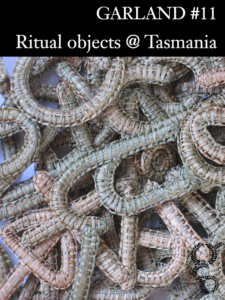Garland #11 ✿ Tasmania: Offerings for the South
In this issue, we move reach across Moana, from Tasmania to Latin America.
We are now entering the second half of our journey. Thus far, we’ve discovered how much creative energy in the Indo-Pacific is devoted to works that are made as offerings. These can be objects used in community festivals, temple dedications or gifts for friends. Issue #11 begins in lutruwita Tasmania and looks across to Latin America, where objects can be used as ways of making amends with a difficult past. These offerings help acknowledge the suffering experienced by previous generations while offering hope for a more just future.
Proposals for submissions are welcome. For details, please go see our guidelines.
Online exhibition – On offer
The online exhibition will feature works that are made as offerings. This is open to artists in any country and aims to offer readers a survey of beautiful and thoughtful objects made today. You are invited to contribute two images: one photo of the object itself and one photo of the object in the world where it appears, such as a street, park, shrine, monument or altar. Images and text are due 20 May 2018. Please submit details in this form here.
The ex-voto offering is a common religious practice in which an object is presented to god(s). This is sometimes a request or a thank you for a particular wish that has been granted. The offerings can include flowers, fruits, symbols, miniature versions of real objects or inscriptions. In a secular context, we see this today in the tributes that can be left in public spaces or installations such as “wish trees” that sometimes appear in festivals.
Votives can seem anachronistic and based on magical thinking that god will reciprocate a gift. But for may the act of offering has worth in itself, reflecting the importance of gratitude in living a satisfying life.
The challenge today is to think of what might be the subject of an offering. Is it to mourn those who departed without their due respect? Or might it be to acknowledge something that otherwise goes without thanks? And where might this offering be placed? Might there be public spaces that can play a similar role to the temple for gathering offerings? Is the gallery an appropriate site for offerings?
And how is this possible? Is the votive necessarily an act of charity, albeit without a specific recipient? Or can the votive be a product that is sold to someone else who makes the offering, as candles might be sold in a temple?
Many questions, but also many possible answers. The result of this invitation will be an expansion of our concept of creative practice, reflecting the values and cultures of the Indo-Pacific.

